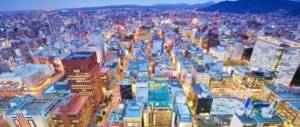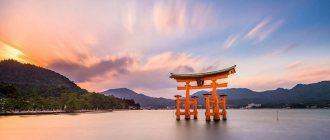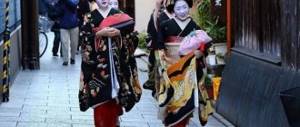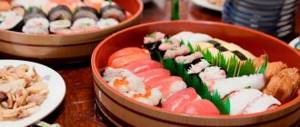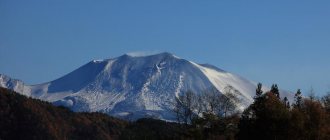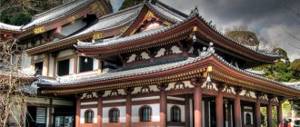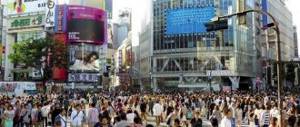Japan is one of the most developed countries in the world. This state has its own thousand-year history, traditions, and unique culture. The country is located in East Asia on the Japanese archipelago, consisting of 6,852 islands. The largest islands of the country:
- Hokkaido
- Honshu
- Shikoku
- Kyushu
Despite the relatively small area, the country's population density is high. Japan has a population of 126,225,000. The state is also called the Land of the Rising Sun. The Japanese themselves often call their homeland Nihon (homeland of the sun). In 1945, the country was attacked with nuclear weapons by the United States. The tragedy claimed thousands of lives; today Japan is the only state in the world against which such weapons were used. But it was able to recover, building a strong economy over the years, and today ranks 10th in terms of living standards.
Only here to this day the ruler is called the emperor. Modern Japanese are very successful not only in the economy, but also in science, biomedicine, robotics, and high technology. Japanese scientists have been awarded various prestigious awards, the Nobel Prize, and the Fields Prize.
The Japanese care about the environment and carefully preserve the country's rich heritage, represented by castles, temples, palaces, and monuments. All of them have survived to this day almost in their original form. More than a million tourists visit the state every year.
TOP 10 most beautiful cities in Japan
- Osaka is an interesting tourist metropolis.
- Kyoto is the guardian of the country's cultural heritage.
- Nara is the oldest Japanese city.
- Ise is a popular home for Ise-Jingu Shrine.
- Tokyo is an ultra-modern metropolis.
- Matsumoto - the charm of historical places.
- Sapporo is a famous ski resort.
- Kanazawa is a fortified city in Japan.
- Nagano is the most mountainous prefecture on the island of Honshu.
- Kobe - the exotic atmosphere of Japan.
Osaka is a national center for entertainment and theater
In terms of the size of Japanese cities, Osaka ranks third. The metropolis is full of life, energy, where there is everything you need for a great time. The city is more permeated with Japanese culture than the capital; the atmosphere and character of Japan are very noticeable. The residents here, according to tourists, are friendly, spontaneous, and sincere. They are famous throughout the country for their great love of food and business acumen. The culinary center of the country is located here; guests can try a variety of dishes, national delicacies, restaurant and street food.
There are many attractions, Osaka is called the Venice of Japan; the metropolis has many lakes, streams, canals, bridges in various architectural styles. Ancient temples have been preserved, which are located next to modern skyscrapers and amusement parks. Must-see attractions in Osaka:
- Bunraku National Theatre;
- national art museum;
- ramen museum (instant noodle museum);
- chess park;
- Osaka Kaiyukan Aquarium;
- Japanese Disneyland;
- Umeda Sky Building;
- science museum;
- Organic Building;
- Sumiyoshi-taisha Temple;
- kingdom of crabs;
- Poisonous fugu fish restaurant.
Yokohama
Yokohama is only 30 km from Tokyo, so getting here is not at all difficult, but definitely worth it. It’s worth it because Yokohama is a kind of city of the future, and all thanks to its futuristic port (the city is located on the ocean) called Minato Mirai 21. It is here that all the most interesting architectural structures are concentrated - a Ferris wheel made in the shape of a clock, and a tower - a landmark, by climbing which you will be able to see the city at a glance, because the height of the Landmark Tower is almost 300 meters. Of course, in the dark, Minato Mirai 21, thanks to the lighting, becomes a truly postcard place. The futuristic style of this city of Japan is successfully combined with natural landscapes - Yokohama has many green park areas and gardens.
You should definitely visit Sankeien, which is a landscape park where traditional architectural elements from all over the country are collected. If you are traveling with children, then you should definitely visit Joypolis or Yokohama Dreamland. These amusement parks will not leave little travelers indifferent. There is no airport in Yokohama; the closest is in Tokyo. It’s not at all difficult to get here from the Japanese capital, because... You can get to Yokohama by high-speed train, which runs between the cities several times a day.
aotaro/flickr
Kyoto is synonymous with traditional Japanese culture
For more than a thousand years, the historical center of the country was concentrated here. Kyoto was the capital of Japan from 794 to 1869. The metropolis is located in the center of the island of Honshu, the old name of the city is Heian. Kyoto is founded in the form of an elongated rectangle; the layout of streets, blocks, and squares is regular and symmetrical. World famous poets, artists, and writers were born here. Many ancient buildings and places of cultural heritage have been preserved in Kyoto, in particular the Imperial Palace, which can be visited as part of a tour. Some city streets are listed as World Heritage Sites.
The national center of traditional practices of chado (tea ceremony) and ikebana (flower arranging) is located here. This is the birthplace of kabuki, a leading center of calligraphy, sculpture, and painting.
It is definitely worth visiting such historically memorable places as the Kyoto Gosho Imperial Palace, where the coronation ceremony of the new emperor of Japan, rituals, important state ceremonies are held, the Kyoto Imperial Residence, the imperial villas of Shugakuin, Katsura. They can only be visited by people over 18 years of age; they must present a passport at the entrance.
Other noteworthy places in the city:
- Nijo Castle;
- Ryoan-Ji Temple;
- Sanjusangendo Temple;
- Fushimi Inari Taisha Shrine;
- bamboo forest;
- Diakaku-ji Temple;
- Gion district;
- philosophical path;
- Buddhist Temple of Pure Water;
- Silver Pavilion;
- Golden Pavilion;
- Kyoto Gardens.
Fukuoka
Fukoka Tower is famous for its impressive views, and local restaurants offer local cuisine, including Hakata ramen (Tonkotsu). But the most interesting things here are the local temples, the shrines of Dazaifu Tenmangu (museum and garden complex), the stunning Kushida Temple, and the ruins of Fukuoka Castle. After exploring the local architectural monuments, visit the marvelous beaches on the largest island of the Kyushu archipelago.
Nara is a famous center of Buddhist culture
The city is closely associated with Buddhism; some of the temples located here have been awarded the status of World Heritage Sites and are the hallmark of Nara. There are places where tourists can learn about the history of the town. The architectural objects of the Seven Great Temples deserve special attention. Almost all of them are active Buddhist temples and occupy a very important position in the religious life of Japan.
Nara is also called a deer paradise, more than 1000 sika deer live here, they calmly walk through the park and city streets. To get to know this ancient city and its culture better, it is recommended to visit the National Museum, which houses works of art related to Buddhism, the Prefectural Folklore Museum, and the Yamato Folklore Park. The Memorial Museum displays photographs of the town and cultural monuments. It will be interesting to visit the Shinto shrine Kasuga-taisha, Toshodai-ji, the Isui-en garden in the Japanese traditional style, the Yoshikien garden, and the Nara-machi quarter.
Sights of Japan: what else to visit while in Japan
A huge convenience for holidays here is regular transport links between the islands, that is, you can, while living in one part of the country, go on excursions in Japan to any city. Information about attractions in different prefectures will help you create a list of priority places to visit.
Nara City (Honshu Island, Nara Prefecture)
Deer in Nara Park
The sights of Japan are not only temples and castles, but also entire cities. One of them is Nara or the City of Deer - a treasure trove of architectural monuments and masterpieces of culture and art.
About 1,600 deer roam freely through the streets of the beautiful city. They say that the first emperor of Japan descended from heaven on a reindeer sleigh. In the 6th and 7th centuries, the city of Nara was the first capital of the country. The main attractions of Japan in the City of Deer:
- Todai-ji Temple,
- buddha statue,
- Isueen garden,
- Kofuku-ji Temple,
- sarusawa-ike pond,
- Kasuga Taisha Shrine,
- Ara-ike pond,
- statues of heavenly generals.
Walking around the city of Nara is a real pleasure. Hundreds of deer walk the streets at ease, they are loved and revered. On every corner you can buy deer food and treat the gentle animals. And at the Sarusawa-ike pond you can see many turtles. They crawl ashore and bask in the sun. A trip to Nara is sure to please art lovers. Todai-ji Temple features a giant statue of Buddha, and the structure itself is perhaps the oldest among wooden temples.
Official website: https://www.visitnara.jp/
Toshogu Temple (Nikko)
Carvings of the Toshogu Shinto Shrine
The Toshogu Shinto Shrine is the main architectural monument in Nikko. The shrine is dedicated to the shogun Tokugawa Ieyasu. This is the most prominent figure in Japanese history, since under him the unification of Japan into a single state was actually completed. Toshogu Temple is striking in its beauty of lines and magnificent carvings, the authorship of which is attributed to the famous sculptor Hidari Jingoro. The sights of Japan would be lost without this picturesque temple. Its main features:
- Sculpture of a sleeping cat nemuri-neko.
- Lush colored carvings decorating the temple.
- Figures of strange elephants with claws.
- The building of the sacred stable, which is the only one not covered with varnish.
- A symbolic image of monkeys - the patrons of horses.
The fine carvings made by skilled craftsmen to decorate Toshogu Shrine attract the attention of tourists from all over the world. The sanctuary is located 130 km from Tokyo. Often the Japanese themselves come to see the famous temple. In addition, the city of Nikko is a national natural park covering a vast area.
To enter Toshogu Shrine, pilgrims must pass through a nine-meter high granite gate, then through a 6-meter high bronze gate. After bathing in the sacred spring, guests can visit the beautiful temple. The legendary shrine is also the burial place of the shogun. It's definitely worth a visit.
Official website: https://www.toshogu.jp/english/shrine/
Peace Park in Hiroshima (Nakajima District, razed to the ground)
The Genbaku Dome after the nuclear bombing
of the Land of the Rising Sun in the post-war period is the new attractions of Japan. The most famous among them is the Peace Park in Hiroshima, dedicated to the memory of the victims of the atomic bomb. On a vast territory there is a memorial ensemble, which includes the Museum of Peace, monuments, a ritual bell and a cenotaph. Demonstrations are held at the memorial site in memory of the Hiroshima tragedy. The cenotaph is a symbolic grave for the victims of a nuclear attack, whose names are engraved on a memorial plaque.
In the middle of the 20th century, the ensemble of Peace Park was complemented by the pedestal of the Japanese girl Sadako Sasaki with a paper crane in her hand. This is a kind of cry of despair of the Japanese who suffered from the impact of the atomic bomb. The girl died from radiation sickness ten years after the terrible tragedy. She dreamed of making a thousand cranes and making a wish, but she didn’t have time...
The fountain of prayer on the territory of the Peace Park appeared a little later. It symbolizes the desire of people yearning to live after the atomic explosion, and embodies the suffering of thousands of people who were not given water. And on the Flame of Peace monument burns an eternal flame, lit back in 1964. The sad architectural monument is a tribute to the memory of all Japanese who suffered from the explosion of the atomic bomb.
Official website: https://hpmmuseum.jp/
Itsukushima-jinja Temple (Hiroshima Prefecture, Miyajima Island)
Red torii in the water
One of the striking examples of Japanese temple architecture is Itsukushima-jinja, located above the sea. The gate of the shrine, which is included in the attractions of Japan, is located at Mount Misen. Their height is 16 meters. The bright gates expressively highlight the surrounding landscape, and they simply cannot be confused with anything else.
The Itsukushima-jinja complex consists of several shrines, each dedicated to a different deity. The main temple of the complex was built in honor of the goddess Mikoto, the patron saint of navigation. Most of the temple buildings are located directly on the water on wooden stilts. The Hall of a Thousand Mats is impressive. It is believed that it was built from only one camphor tree trunk.
There is a treasury located on the shore of a sheltered bay from the wind. It contains antiques, masterpieces of art and ancient scrolls donated to Itsukushima-jinja Shrine. Every tourist can experience the truth of the statement that passing under the temple gates will bring good luck and wealth.
Official website: https://www.en.itsukushimajinja.jp/
Imperial Palace (Tokyo)
Imperial Palace in the park area of Tokyo
What could be more luxurious and richer than the Imperial Palace? The sights of Japan are amazing, but the Imperial Castle cannot be compared with anything else. It is located in the park area of Tokyo; in total, the palace buildings occupy an area of 740 hectares. The country's government offices are located near the Imperial Palace. But the modern neighborhood does not in the least disturb the beautiful palace architecture.
A snow-white building with a pointed roof, the castle consists of two floors and one underground. The interiors of the Palace are made in Japanese style. The castle is surrounded by protective moats filled with water. There is a picturesque natural oasis around the palace.
The Castle houses the residence of the Japanese Emperor. Much to the regret of tourists, you can only admire the palace architecture from afar - walking around the Castle grounds is not allowed. However, twice a year those wishing to visit the Imperial Palace can take advantage of a unique chance - after the New Year celebrations and on the Emperor’s Birthday, access to the internal gardens of the complex is open.
Official website: https://sankan.kunaicho.go.jp/
Hakone
Mount Fuji and Lake Ashi in the Fuji-Hakone-Izu National Park Panorama of the Owakudani volcanic valley in Hakone The
island of Honshu is one of the main islands of the Japanese archipelago, where most of the population lives and the main attractions of the country are concentrated. And one of the interesting places is located in Kanagawa Prefecture - the village of Hakone, which is famous for its hot springs. It is also one of the best Japanese resorts, where you can feel the national spirit, visit a number of historical buildings, open-air museums, and relax in super-equipped hotels and spa complexes. And most importantly, from here you will have the opportunity to see with your own eyes the familiar peak of Mount Fuji, already familiar from childhood, covered with a snow-white cap of snow.
Official website: https://www.env.go.jp/en
Todai-ji Temple
Main Hall of Todaiji Temple in Nara
Nara, Japan's national heritage city, is home to a number of Buddhist temples, the key one being Todaiji Temple. This is the most important symbol of the city, a sacred place of pilgrimage for many millions, where daily services began in the 8th century and continue to this day. Besides everything, the temple is also interesting because it is the world's largest wooden structure, and also houses the world's largest bronze statue of Buddha within its walls. In order to get inside the temple, you will need to go through the ancient wooden gates of Nandaimon, through a hall filled with clouds of smoking incense, and only then your view opens to the Big Buddha Hall, where a majestic statue of the deity gazes down from its 15-meter height.
Official website: https://www.todaiji.or.jp
Shibuya area
Top view of a diagonal pedestrian crossing in the Shibuya area at dusk.
Sakura has long since faded, but golden autumn in Japan is still far away? The scorching July heat and high humidity are extremely difficult conditions for active travel, but locking yourself in a hotel is not an option for active guests of the country. If you're looking for things to see in Japan in July, we recommend visiting Shibuya, a hotspot for Japanese youth filled with trendy boutiques and department stores. The fact is that in this summer month, sales start in the most prestigious stores of Shibuya, and the area turns into a real paradise for shopaholics and simply those who have become tired of the standard set of consumer goods, and leaving a tidy sum in expensive boutiques is an unaffordable luxury.
Kiyomizu-dera Temple
Kiyomizu-dera Temple on a picturesque mountainside
On the slope of Mount Otowa in Kyoto there is a vast temple complex that has become a symbol of the city. This is the Temple of Pure Water, or Kiyomizu-dera, built in the name of the goddess of luck. The buildings of the complex that have survived to this day date back to the 30s of the 17th century. Today the temple is a place of pilgrimage for millions - about 3 million people visit it every year. In addition to the building of the temple itself, on its territory there are: a 3-tier pagoda, a library of sutras, several pavilions, as well as a number of small temples. There is also an observation deck where you can enjoy beautiful views of Kyoto from above. A remarkable feature of this site is that it was built using 139 supports, but without a single nail.
Official website: https://www.kiyomizudera.
Matsumoto Castle
The beautiful medieval Matsumoto Castle in the eastern part of the island of Honshu
On the island of Honshu, in the city of Matsumoto, it is recommended to visit the ancient Crow Castle, so named because of the black facade and side towers resembling outstretched wings. The extraordinary architecture of the building is in extraordinary harmony with the beauty of the surrounding nature. The area of all the buildings of the castle and surrounding areas is enormous - it is 39 hectares. This includes the citadel itself, the water-filled moats and the fortress wall surrounding the entire area. A notable feature of the complex is a series of chaotically arranged steep staircases and a confusing arrangement of rooms - all of which were erected in such a way as to disorient the enemies who raided during the Middle Ages during the period of feuding provinces.
Official website: https://www.matsumoto-castle.
Kamakura
Long sandy beach in Kamakura
One of the oldest Japanese cities is located south of the Japanese capital, on the island of Honshu. This place attracts numerous tourists with its countless attractions, coupled with a comfortable climate - there is no sweltering heat or severe frosts here. It seems that the ancient city has seen everything in its century - from tsunamis and typhoons, to earthquakes and wars. And yet, today about 170 ancient monuments of great historical value have been preserved here. Among them are temples with numerous Buddhist relics, ancient sculptures and statues of Buddha, as well as museums, hotels, restaurants and even white sand beaches, perfectly equipped for a comfortable stay.
Kegon Falls
Kegon Falls and Lake Chuzenzi in Nikko National Park
August is another month of sultry heat in Japan, not the most favorable time for active trips to museums, theaters and other cultural sites, the heat very quickly deprives you of strength. When choosing what to see in Japan in August, we recommend paying attention to natural attractions, such as the Kegon Falls, whose crystal waters give visitors invigorating coolness. And the walk itself through the beautiful Nikko National Park, where the waterfall is located, will give you a boost of energy and an indelible impression of the dizzying views. The height of the waterfall reaches hundreds of meters, and there are several observation platforms to observe it. As a bonus for an impressive walk, there are 12 more small waterfalls that cascade nearby through numerous mountain crevices.
Official website: https://nikko-travel.
Naruto Whirlpool
Tidal whirlpools in the Naruto Strait
One of the extraordinary natural phenomena of Japan periodically occurs in the Naruto Strait, which connects two prefectures - Tokushima and Hyogo. The strait itself, connecting the Indian Ocean with the Inland Sea of Japan, is small in width - just over a kilometer. Twice a day, the current first raises and then lowers the level of the Inland Sea, thereby creating a difference between the levels of the outer ocean and the sea. In this case, the current speed increases to 15-20 km/h, and an amazing phenomenon occurs - whirlpools, the diameter of which reaches 20 meters. Typically, the eddies are larger in the summer than in the winter. There are regular cruises to the strait, allowing you to see the whirlpool in all its beauty.
Okinawa Island
Okinawa Island is an attractive holiday destination
When going to the south of Japan, where the attractions are not so numerous, your trip plan should definitely include a visit to Okinawa, an island that is part of the Ryukyu archipelago. It is the warmest prefecture in Japan, and the only one located in the subtropical zone. This is why the island is so attractive for holidays all year round, and even in the coldest January period, the average daily air temperature here does not drop below +17 degrees. The restored Shurijo Palace on the island reminds of the grandeur of the medieval Ryukyu Kingdom. The ruins of fortifications, which have become World Heritage Sites, are also scattered throughout the island.
Snow Festival in Sapporo
Man-made sculptures made of snow and ice at the Snow Festival in Sapporo Akinori YAMADA
Japanese culture is extremely rich and extraordinary, and many Japanese traditions were formed under the influence of some important historical events. Some traditions date back thousands of years, while others are more recent. A living example for the latter is the Sapporo Snow Festival. In 1950, several high school students from one of the city schools erected 6 animal sculptures in Odori Park. Since then, every year at the end of winter, the townspeople organize a grand sculpting of figures from snow and ice. Since the 2000s, the festival has become the largest winter event in the country, and it is included in the attractions of Japan for children when drawing up tourist programs.
Official website: https://www.snowfes.com
Kusatsu Hot Spring Town
Kusatsu Hot Springs in the central square of Yubatake
The Land of the Rising Sun is located on lands of volcanic origin, so hot springs are a common occurrence here. Since time immemorial, the inhabitants of the country have used the beneficial properties of volcanic waters to treat soul and body. Kusatsu is one of the most famous resorts of international importance based on thermal water treatment. There are a lot of groundwater outlets here, and the central place is occupied by Yubatake, the largest of the sources. The water coming out here crosses the city square along specially laid channels, and at the end of the path it falls into a small waterfall - the intensity of the flow in this place reaches 4 thousand liters per minute.
Kumano Kodo Pilgrim's Trail
One of the ancient Kumano Kodo pilgrimage trails
Kumano Kodo is a large system of extensive pilgrimage trails on the island of Kii. Having arrived here, pilgrims have the opportunity to visit places of ancient power, periodically stopping at guest houses located along the route. For centuries, pilgrims of the Shinto religion moved along these paths, and it was believed that the forests of the peninsula were inhabited by Shinto deities - kami. Over time, with the spread of Buddhism, kami began to be presented as incarnations of Buddha. All trails are famous for their fabulous beauty, leading through mountain forests, rivers and along the ocean coast. Almost all routes of the famous trail converge in the city of Hongu, where the most important sacred temple is located - Taisha.
Sankei-en Garden
A cozy green corner in the Sankei-en garden naitokz
One of the most beautiful, quiet and cozy places in Yokohama can be called the Sankei-en garden. This is a spacious park area of about 180 square meters. kilometers. Here you can take a break from the bustle of the city, admire the amazing beauty of nature, see a lush variety of plants collected from different parts of the planet, and also visit a number of historical buildings - there are 17 of them in total. In particular, this is a 3-story pagoda of the 16th century, brought from Kyoto , Choshukaku tea house, a medieval peasant house from Gifu Prefecture, introducing visitors to the life of ordinary people. The impression is complemented by picturesque ponds and fragrant flowers - sakura, azaleas, chrysanthemums, lotuses.
Minato Mirai (Yokohama)
Minato Mirai District 21 of Yokohama from a bird's eye view
The central area in Yokohama is the business district of Minato Mirai, the most attractive for guests of Greater Tokyo. Those who arrive here have the opportunity to engage in shopping, various types of recreation and entertainment, visit cultural monuments and a number of thematic exhibitions. Notable sites include the 70-story Landmark Tower, the Sky Garden observation deck with breathtaking views of the harbor, museums of art, toys, industry, history, as well as the Nipon Maru Silk Museum and Maritime Museum. The area continues to actively develop, and the list of its attractions is constantly updated with interesting new products.
Official website: https://goyokohama
Ise is the most important religious center of the country
The town is located 300 km from the capital of the state. Here is the most important religious center of the country, an object of mass pilgrimage, a repository of Shinto treasures, represented by ancient, great shrines, closely connected with the history, cultural, and spiritual life of the Japanese people. The local nature, dense green hills and forests amaze the eye.
Ise-Jingu Shrine is a very popular shrine all over the world. In Japan, every resident knows about it. It consists of two groups of temples - external Naiku and internal Geku, dedicated to the goddess Amaterasu. In addition to the temple, guests and tourists visit the museum of fine arts, history, agricultural museum, and library. All of them are part of the sanctuary.
A famous place is the town's historical district - Kawasaki, located along the Setagawa River. The area was once an important trading place, hosting more than a million pilgrims a year to Ise-Jingu Shrine. Ships entered the town along the river. Today, only the main street has been preserved, where you can buy various souvenirs and much more.
Geography lesson
Japan is located on islands and archipelagos. From school lessons you probably remember the names of the large islands: Hokkaido and Honshu, Shikoku and Kyushu. You will be surprised to find out how many islands Japan consists of. In fact, there are more than 6 thousand of them. The islands of Japan are located in a seismically dangerous zone and have 50 active volcanoes.
The list of Japanese wonders is topped by the sacred Mount Fuji. This is followed by cherry blossoms and the Momiji Maple Leaf Festival. Admiring natural beauty is possible only during a certain season. And famous cities with skyscrapers and pagodas welcome tourists at any time of the year.
Here is a map of Japan with islands in Russian. First of all, you will want to visit the main islands and explore the most interesting cities. How to build a route to see as much as possible in a short period of time? It all depends on the time of year and your preferences.
Tokyo - the famous capital of Japan
A huge, ultra-modern metropolis - the center of the country's various cultures, the capital of Japan. Large-scale events are held here, for example, one of the largest Kanda Matsuri festivals, the Hanami Flower Admiring Festival in Ueno Park, and the fireworks festival. Exhibitions are held in museums, music events and musicals are held at venues. Tokyo is home to several hundred art galleries and dozens of public and private museums. The Tokyo National Museum stores more than 85,000 works of painting, art, and sculpture.
Life here does not stop either day or night; during rush hour people seem to merge into one stream. It’s easy to get lost in the city if you lose your attention even for a short time. To see the sights and soak in the amazing atmosphere, you need to stay in Tokyo for at least a few months. Here ancient Japanese traditions and modernity harmoniously merge. The oldest universities are located in the metropolis:
- Keio
- Waseda
- Hosei
- Tokyo
One of the most important memorial sites in the city is the palace of the Emperor of Japan. Other noteworthy places in Tokyo:
- Edo-Tokyo Museum;
- the noisiest district in the city is Ginza;
- Tokyo Skytree;
- Kabuki-za theater;
- automobile museum Toyota Mega Web;
- Disneyland;
- Tokyo National Museum;
- Kotoku-In Temple;
- Geisha Street;
- Asakusa district;
- Buddhist temple Senso-ji;
- Cathedral of the Resurrection of Christ;
- Center-Guy;
- Akasaka Palace;
- Tokyo Dome City.
Matsumoto - Gateway to the Japanese Alps
The town is located in the central part of Honshu, charming with historical places. It is also called Chubu, the gateway to the Japanese Alps. The representative of modern Japanese art, Kusama Yayoi, was born here. Matsumoto is divided into two parts by the Metoba River. To the south is the area of ancient traditional buildings Nakamachi. Many houses have been turned into hotels, shops, and restaurants. The sake distillery will be of interest to guests of the town.
The Ukiyo-e Museum houses a stunning collection of 100,000 woodblock prints, including works by Hokusai and Hiroshige. Other objects and places will be of interest to tourists:
- Tenjin Matsumoto Fukashi-jinja Temple;
- Kaiti Gakko Primary School;
- Matsumoto Folk Crafts Museum.
Sendai
Some of the country's most famous festivals take place here. Every year, the leafy streets of Sendai attract a huge crowd of people who come from all over Japan to enjoy the Tanabata Matsuri festival. The Japanese believe that any wish made under the stars on this day will surely come true.
Sendai is located in the Tohuko region and is the largest city in the area. Tourists get the opportunity to experience local culture and explore fascinating attractions.
Party-goers will find their groove in Sendai, with its vibrant nightlife. Explore a delightful ruined castle, beautiful gardens and more. From here you can also head to nearby hot springs or Matsushima, which offers some of the best views in Japan.
Sapporo is a paradise for Japanese food lovers
A large metropolis is located on the island of Hokkaido and is the capital of Hokkaido Prefecture. The city is quite young for the country; it was founded in 1868. Sapporro is known in the world for the fact that the Winter Olympic Games were held here in 1972. It is important for tourists to know that smoking is prohibited in the center of the metropolis. For this purpose, there are specially designated places where you can enter only after presenting your passport.
In February, it hosts the Odori Park Snow Festival, which attracts approximately 2 million visitors. Everyone takes part in a sculpture display, a snowball fight, and ice skating. If you are wondering what food to try in Sapporo, the answer is simple - ramen. The dish, like its name, originated in this city.
Most of the attractions date back to the modern era of Japan. The most interesting places for excursions:
- Odori Boulevard;
- confectionery factory "Isia";
- Niihama Airport;
- Brewery Museum;
- Sapporo Botanical Garden.
Entertainment for the whole family for every taste can be found in the Susukino quarter.
Okinawa
Start your exploration of Okinawa by visiting Chibana Castle, the botanical garden, local museums, and then head to the local beaches with coral reefs. The island city of Okinawa is an archipelago prefecture consisting of more than 150 small islands, located between Kyushu, one of the largest Japanese islands, and Taiwan, on the border between the East China and Philippine seas.
Kanazawa - a city of museums
The ancient fortress city is located in the west of Honshu. The name translates as “golden swamp”. Kanazawa is surrounded by the Japanese Alps and two rivers flow here:
- Asano - feminine, gentle river;
- Saigava is the only male river (it is believed).
The city is popular for tea ceremonies, traditional crafts, especially Wajima-nuri lacquerware and Kutana-Yaki ceramics. Interesting museums:
- the Honda Family Museum, where dishes, weapons, and art objects of the family are displayed;
- the art museum presents to visitors collections of special Kutani ceramics;
- the Nakamura Memorial Museum, where collections for the tea ceremony and handicrafts are kept;
- a museum of crafts and traditional products, where interesting collections of Yuzen silk, ceramics, lacquerware, and musical instruments are exhibited.
Nagano - beautiful rivers and mountains
The city has many mountains, rivers, lakes, and springs. Nagano is famous for its natural beauty. A very popular dish that visitors should try is buckwheat soba noodles. The Tokakushi-Soba Museum even hosts master classes on cooking and tasting noodles. The museum displays artifacts that were once used to make soba noodles.
Sights of the city:
- Zenkoji Temple;
- Matsumoto Castle;
- Matsushiro Castle;
- Alley of Nikko Cedars;
- snow monkey park;
- Kawanakajima Field;
- Kamikochi Plain;
Kobe is a port city
The metropolis consists of villages with an exotic atmosphere, the most striking of which are Nankinmachi and Kitano-Jinkan. There is a port in Kobe, next to which there is a port park, a port tower, and Meriken Park. Those who love shopping will be interested in visiting the Umie Mosaic shopping center.
In 1995, Kobe was hit by a major earthquake, which left the city heavily damaged and killing more than 6,000 people. But the residents found strength, united and, with the help of state funding, restored the metropolis. Among the attractions worth noting:
- Art Museum;
- Minatozawa Tomb;
- mosque;
- Suma Temple;
- Sorakuen Park;
- European old quarters of Yamamoto Street;
- aquarium.
The city is connected to Awaji Island by the world's longest suspension bridge. In December, the Festival of Lights was held in Kobe, attended by about 4 million people.
Hiroshima
The legendary Hiroshima survived the US nuclear attack in August 1945, but more than 90,000 people died and colossal environmental damage was caused. The memorials will be of interest to those who are fascinated by the history of the Second World War. But besides the memorial sites associated with the explosion, there are unique attractions here - the floating gate of Itsukushima, a world famous Shinto shrine.
